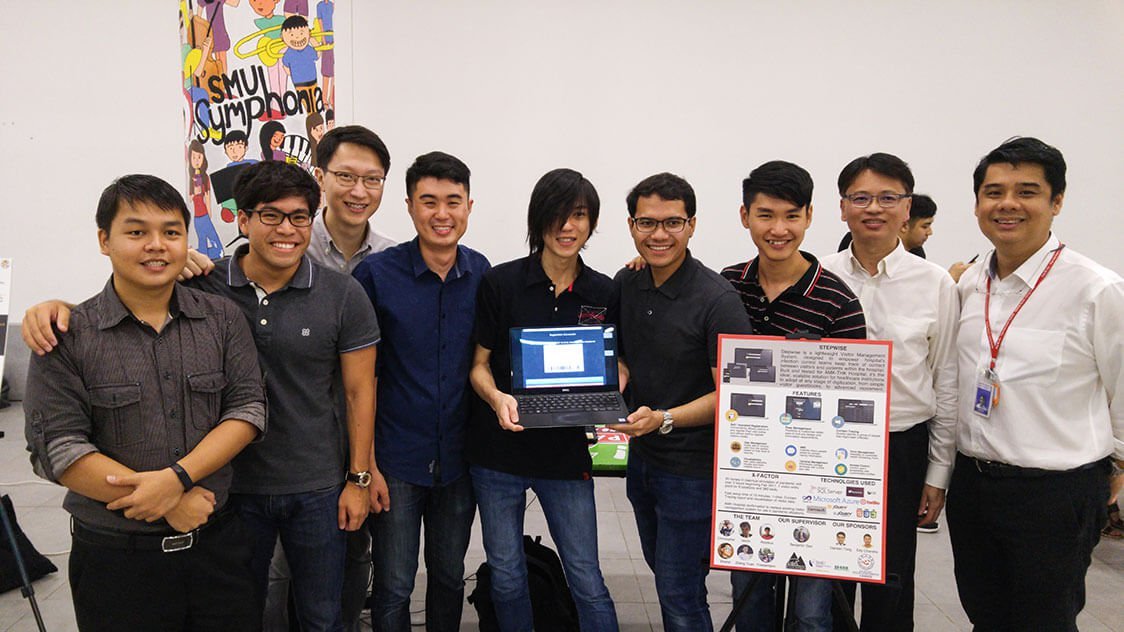
The pace of disruption in the healthcare sector lags behind that of many industries—held back by concerns of data security, patient privacy and a cultural preference for human interaction on matters of medical concern.
But the quest to ensure sustainable healthcare provision for ageing populations around the world is now driving demand for innovation in the healthcare sector. And that’s where a group of SMU School of Information Systems final year undergraduates saw an opportunity to make an impact with their final year project.

Team Grizzly Badgers IS480 Final Presentation
The innovative team of six—Jason Wu Jiawei, Aloysius Lam Zhao Yin, Friedemann Ang Zhuang Kai, Abdul Shahid bin Rahmat, Yu Zheng Yuan and Christopher Teo Ming Jian—have developed a digital system which tracks the contact between hospital patients and their visitors to help prevent the spread of infection.
“Preventing the spread of infectious diseases is a key public health problem in hospitals, and contact tracing is a huge part of the solution,” says Jason Wu, “Traditional methods involve tedious bookkeeping, and many hospital management systems are complex to use and costly to maintain.”
Singapore is no stranger to epidemics and pandemics and began to use data to alleviate the impact of these events following the SARs and H1N1 crises, but Friedemann Ang says the team spotted an opportunity to take this one step further, “What struck us was that the wealth of data was still being collected and aggregated using fairly simplistic methods, and the more advanced analysis tools are unavailable, so we wanted to bridge that gap.”
The system—called Stepwise—is being piloted by Ang Mo Kio-Thye Hua Kwan Hospital (AMKTHKH), and applies user-friendly and cost-effective technology to trace contact between visitors and patients.

Ang Mo Kio-Thye Hua Kwan Hospital Main Building Entrance
Time is of the essence during a pandemic and so as soon as it’s established that a particular patient has contracted an infectious disease, Stepwise is a one-click solution which enables healthcare providers to track visitors who have been in contact with the patient; and alert the healthcare authorities to take measures to prevent further spread of the disease.
Aloysius Lam says their aim was to develop a simple, affordable solution that would be accessible to smaller as well as larger healthcare organisations.
“Visitor tracking systems do exist in our world today,” he elaborates, “However, our team realised that these solutions are only being used by large healthcare organisations which have the means to set up the infrastructure required to maintain it.”
It took the team almost seven months to build the Stepwise application. A considerable amount of that time was spent conducting meticulous research including interviewing key stakeholders—such as infection control teams and management information systems team, and visits to hospitals to study and observe floor plans and the visitor/patient flow rate.

Team Grizzly Badgers Weekly Project Review Meeting
“We also utilised our own experiences when we visited government hospitals to feel what the user experience was like”, explains Aloysius, “We found that there is a need to develop an extremely lightweight and flexible system which could be deployed in multiple locations. The system needed to fit into the hospital’s existing infrastructure which was already tagged to a specific service provider,” he adds.
As with any successful team effort, the team had some challenges to overcome during the development process—meeting tight deadlines, combining different skills and accommodating different working styles, as well as acquiring the necessary technological skills and platform knowledge.

Team Grizzly Badgers IS480 Midterm Presentation & Review
“SMU’s focus on projects, collaborations and self-directed learning put us a step ahead in our ability to work together as a team to complete this challenging project,” says Aloysius.
And overcoming these challenges has definitely paid off. Replacing the largely manual system used at AMKTHKH, Stepwise has been received positively.

Ang Mo Kio-Thye Hua Kwan Hospital Staff Training Session

Ang Mo Kio-Thye Hua Kwan Hospital Official Pandemic Drill with Triage 2.0 System
“Staff are generally open to using this system and have provided us with valuable feedback to help us develop a system that is both functional and easy to use for the target audience,” says Aloysius.
And the Stepwise technology could eventually have life in other sectors he says, “This application is very lightweight and requires almost no installation of support software to run it. However, this application can support future connections to more complex infrastructure such as gantries with a little modification.”
[Feature Photo: Team Grizzly Badgers IS480 Poster Day with AMKTHKH Staff. Left to Right: Edy Chandra (Systems Analyst), Aloysius Lam (Full Stack Developer), Friedemann Ang (Back-end Developer & Database Specialist), Yu Zheng Yuan (Systems Analyst & Quality Assurance), Jason Wu (Back-end developer & database specialist), Abdul Shahid (Lead front-end developer), Christopher Teo (Scrum Master & Business Analyst), Ong Seng (MIS Manager), Damien Tong (HR Director)]


